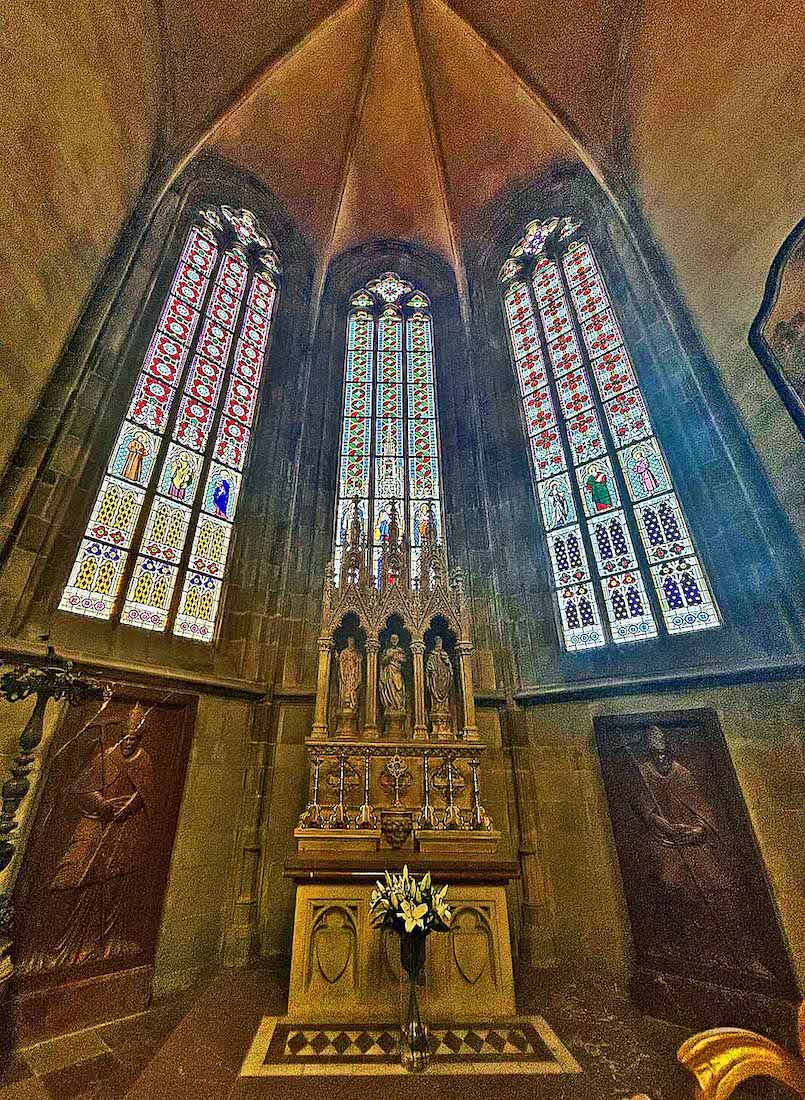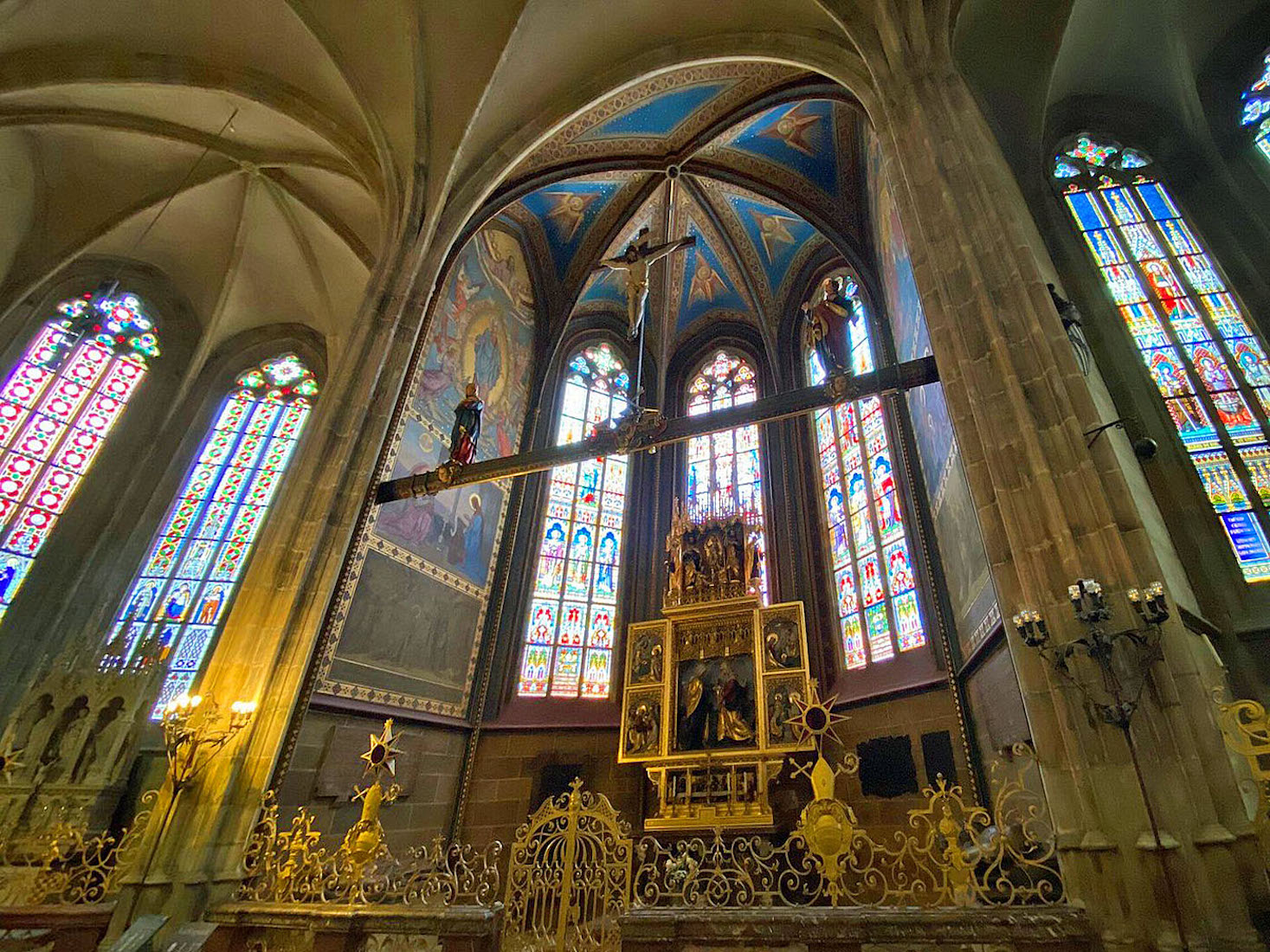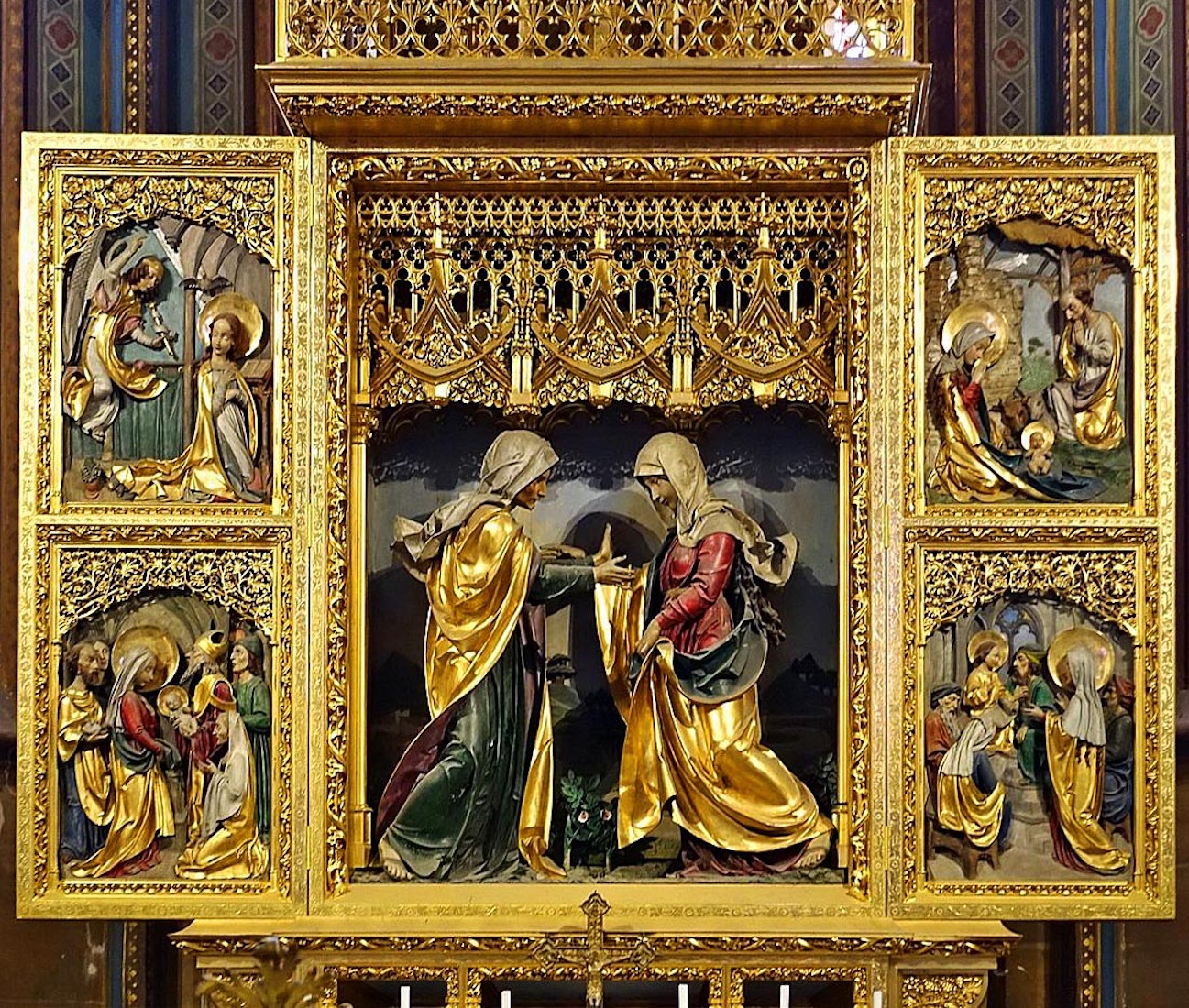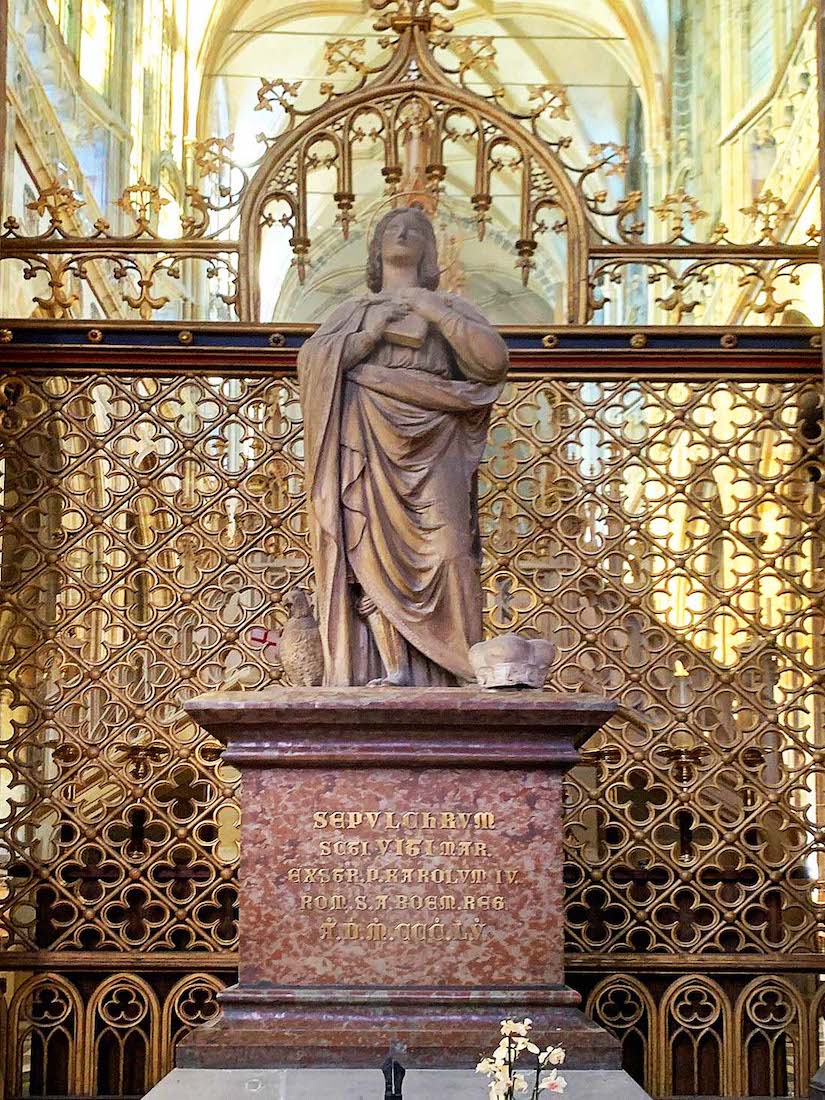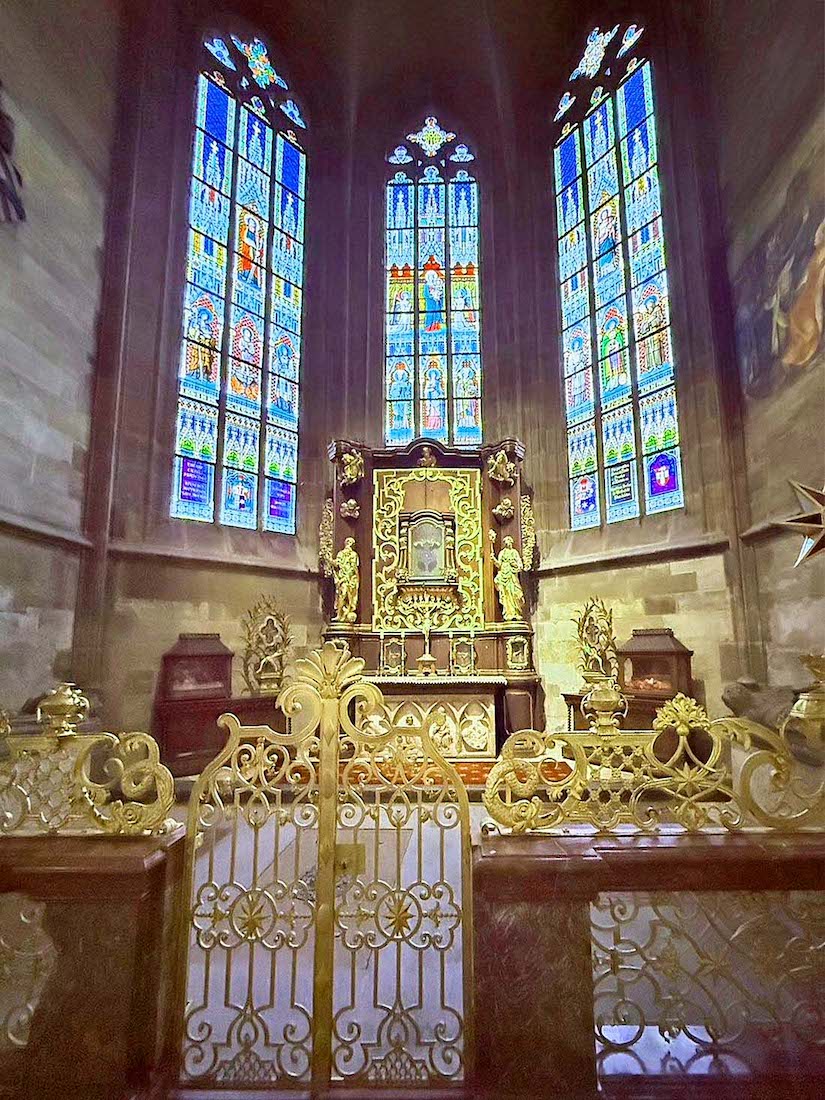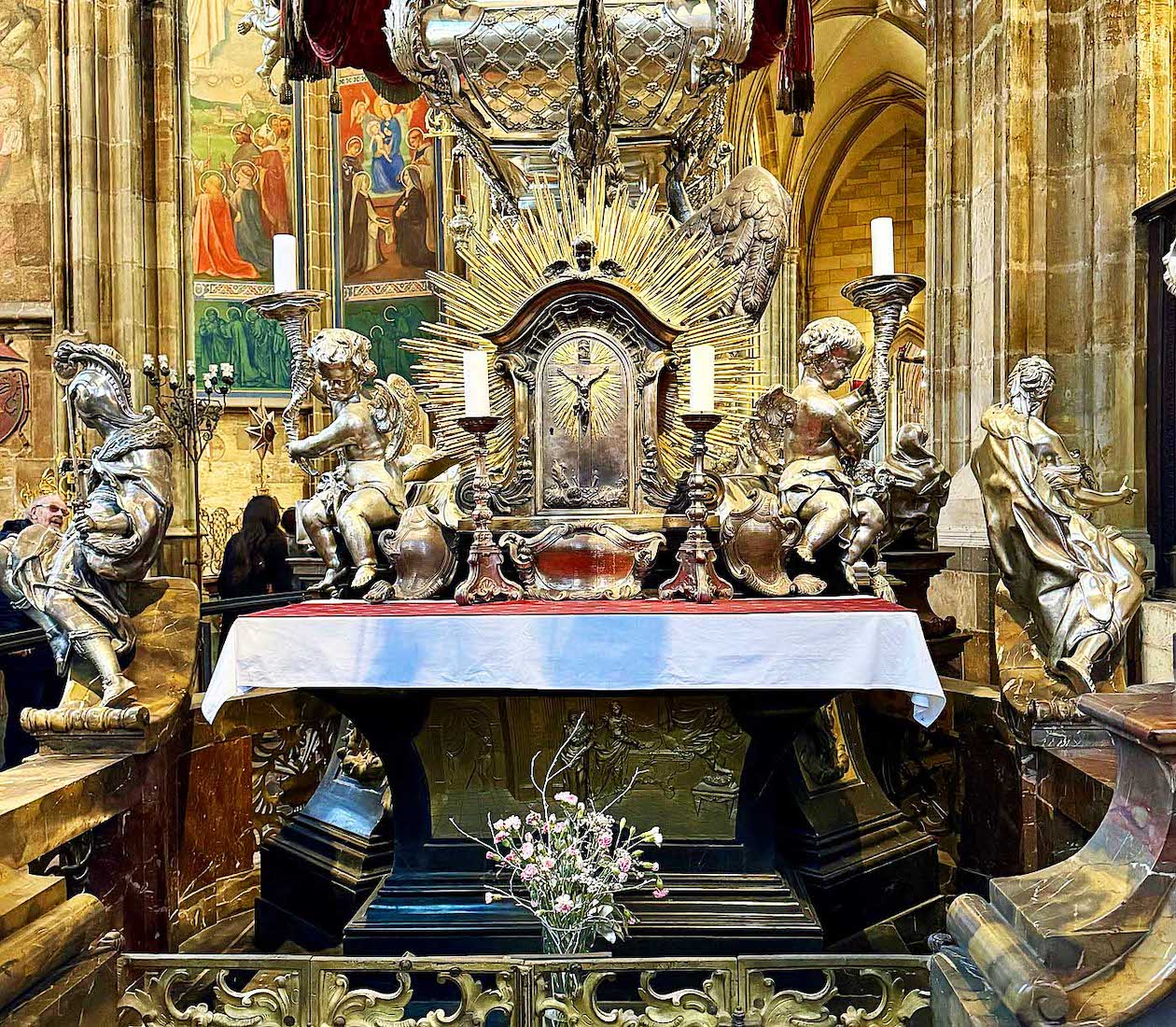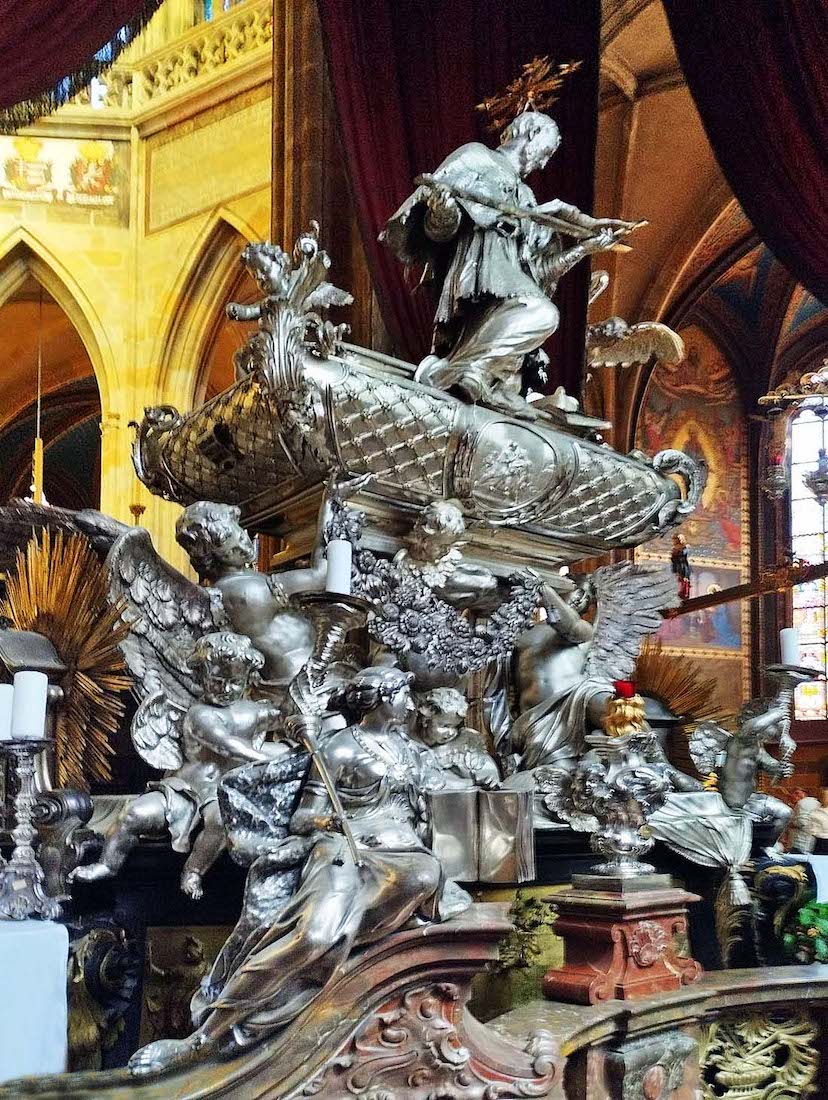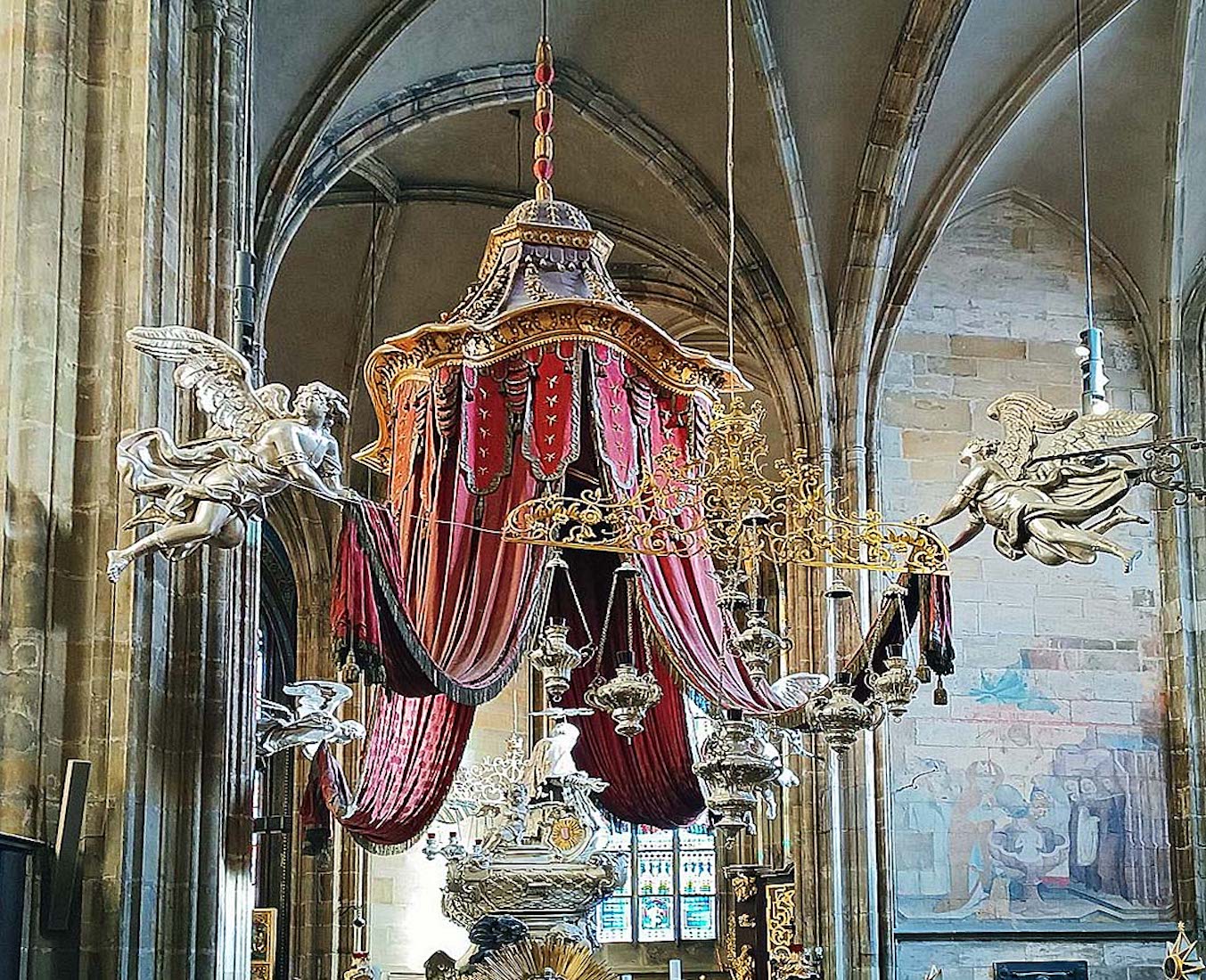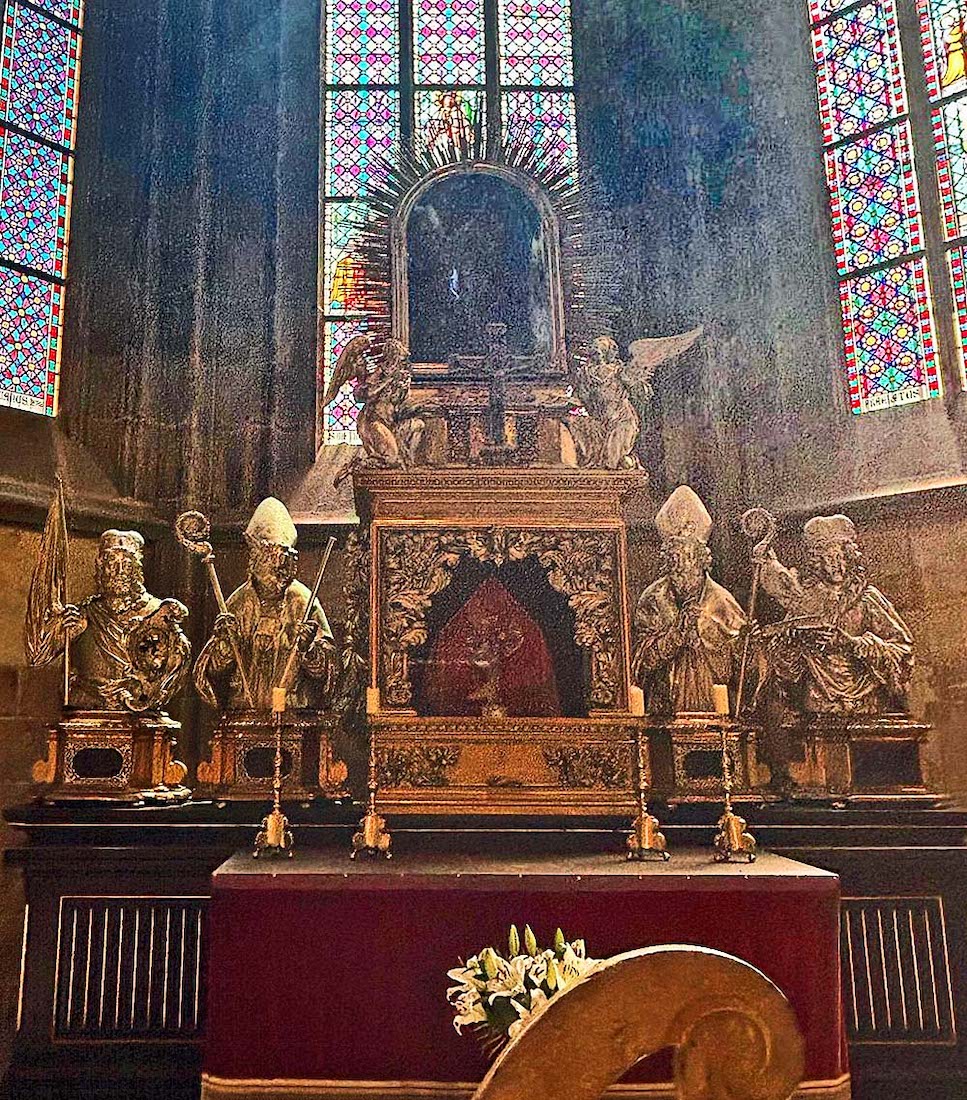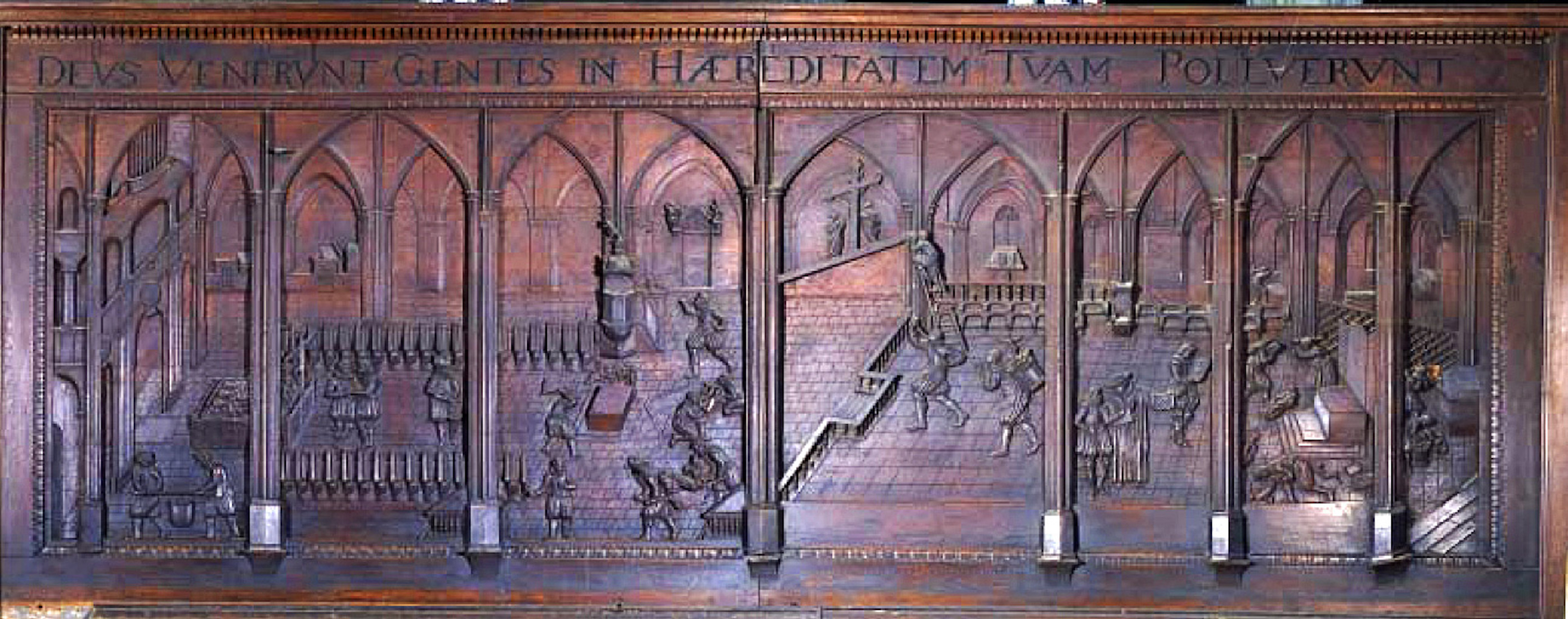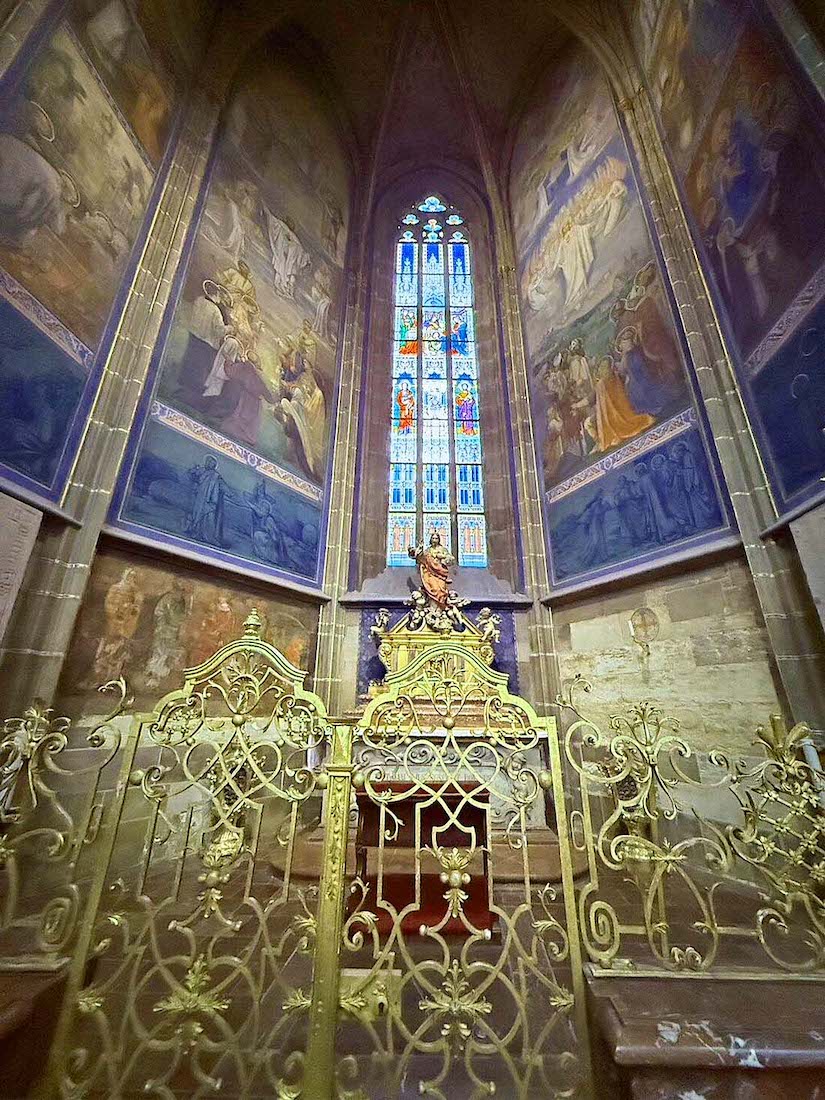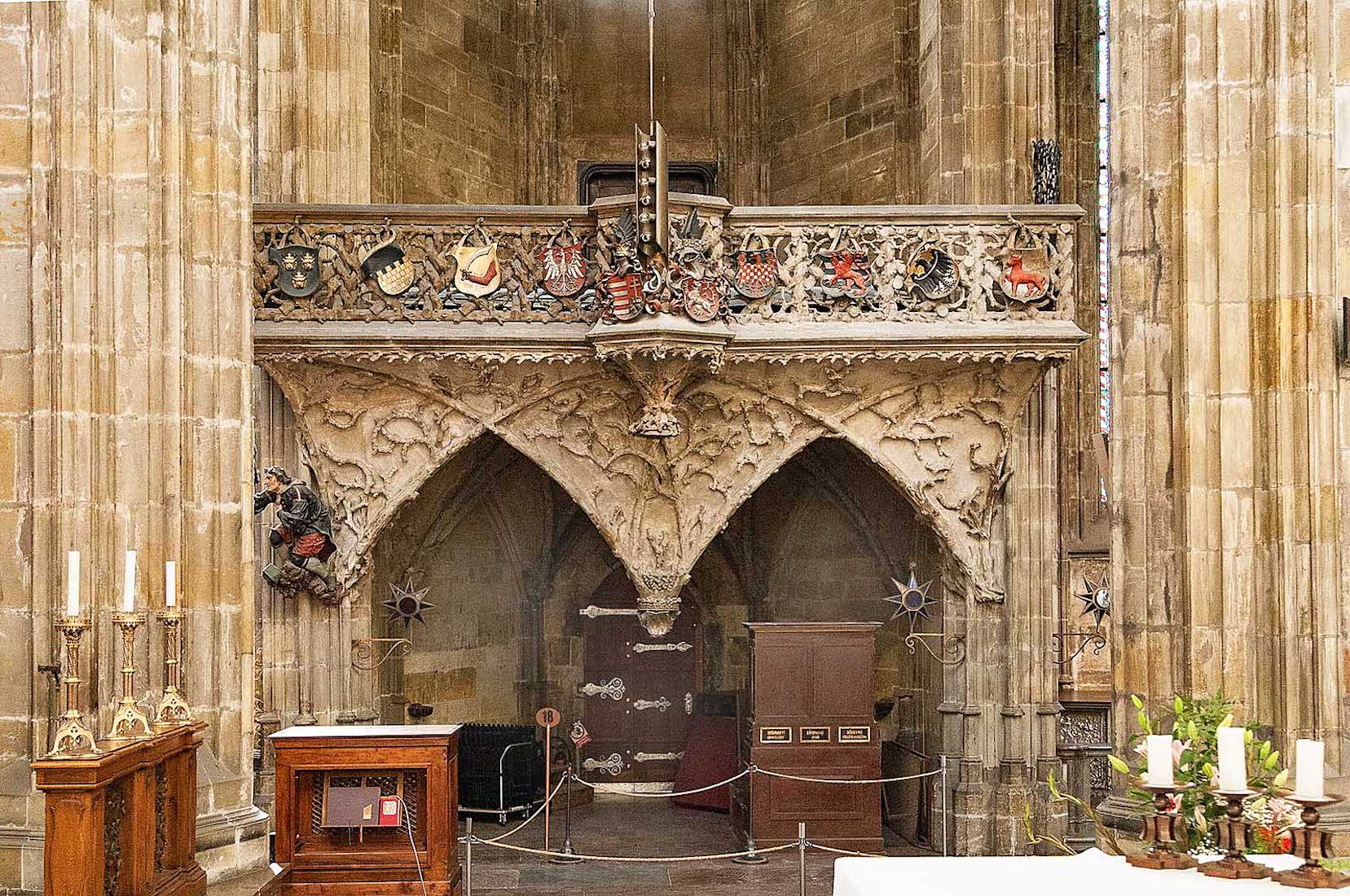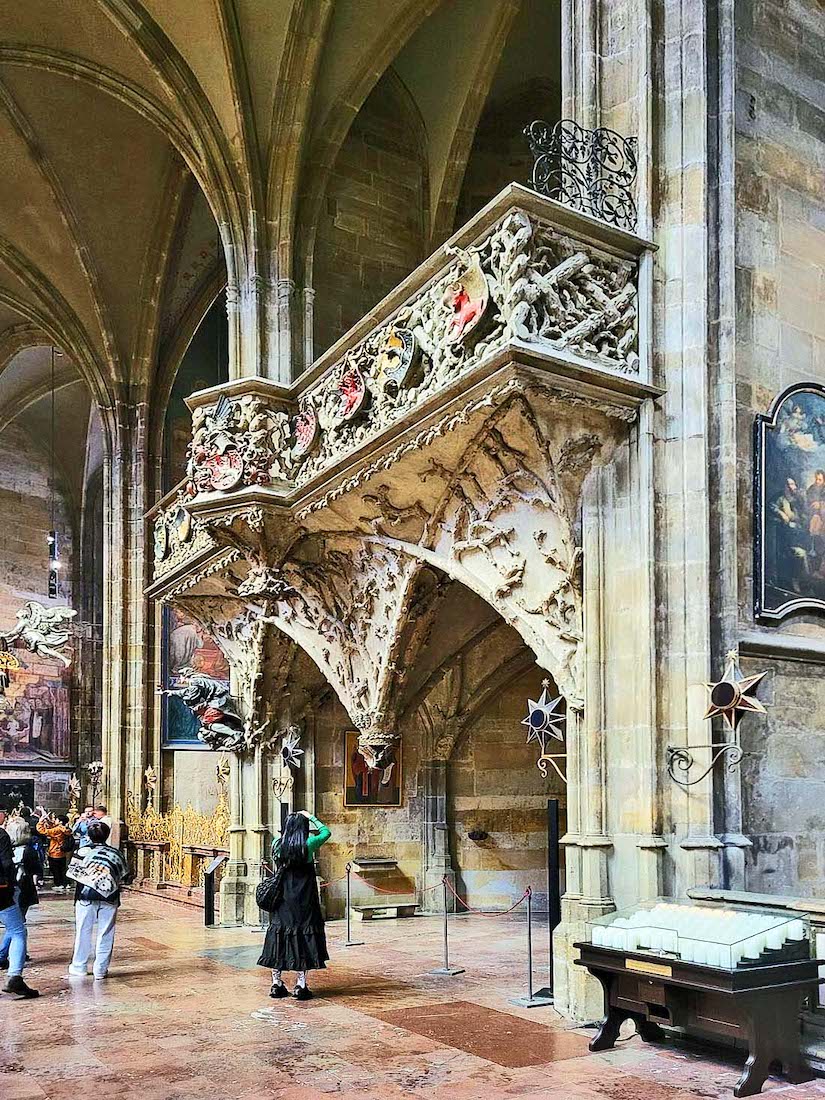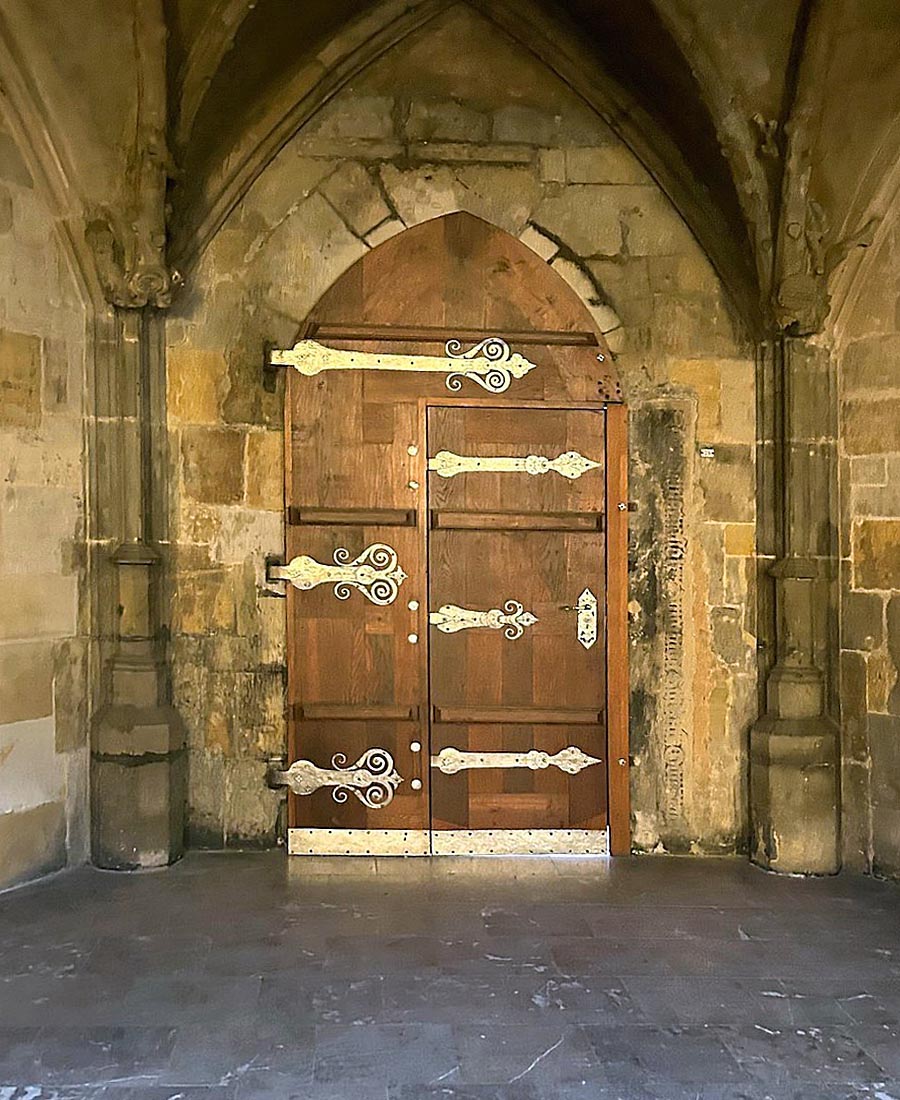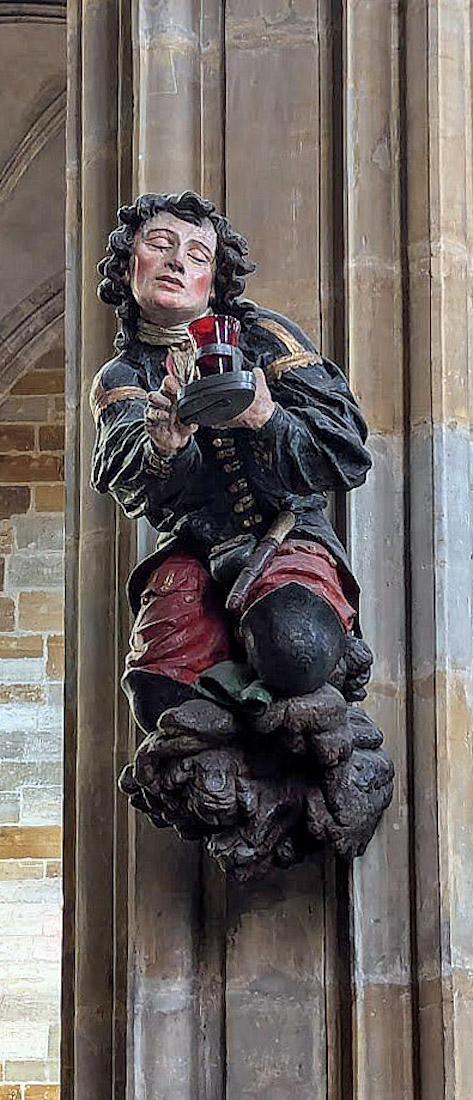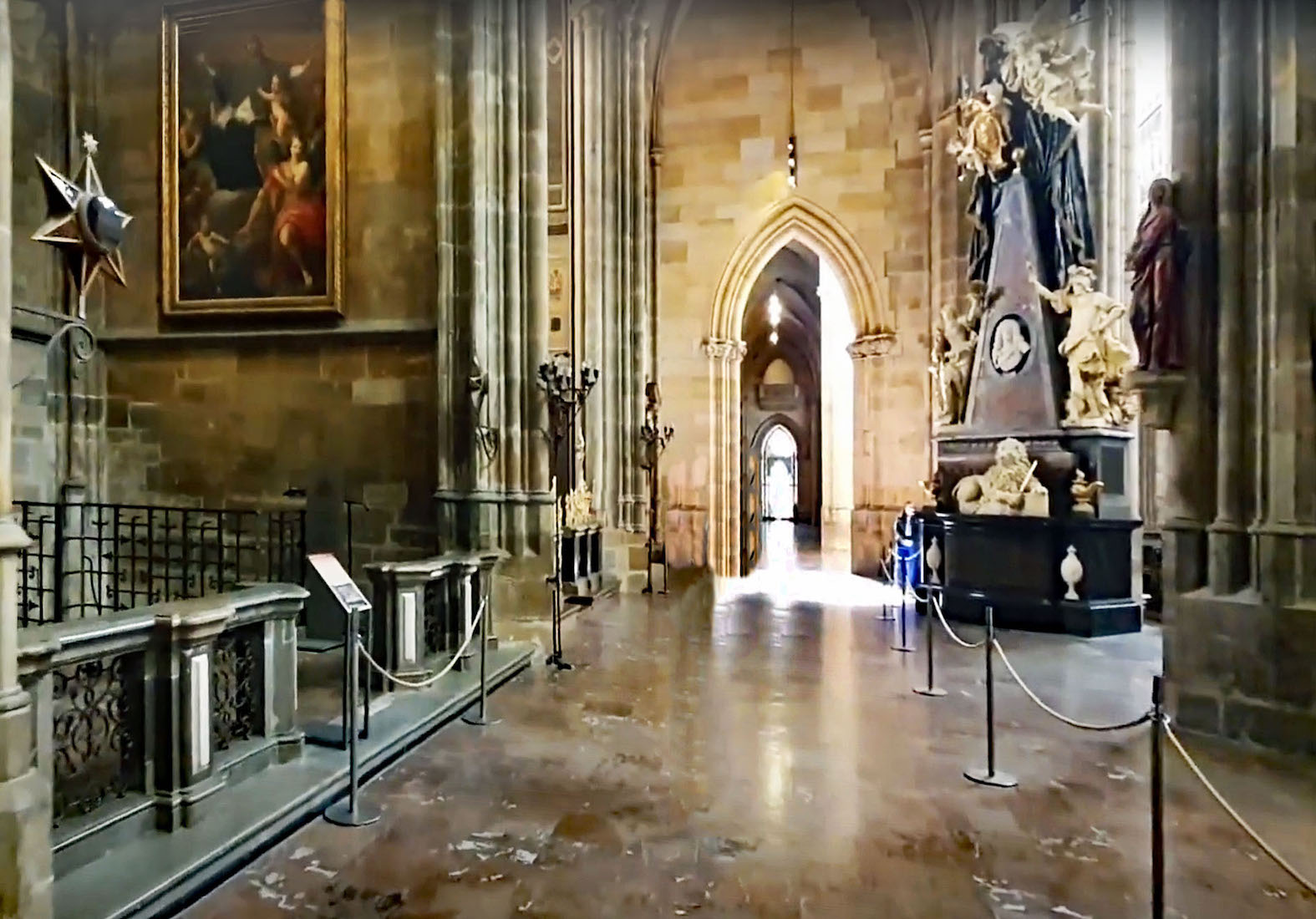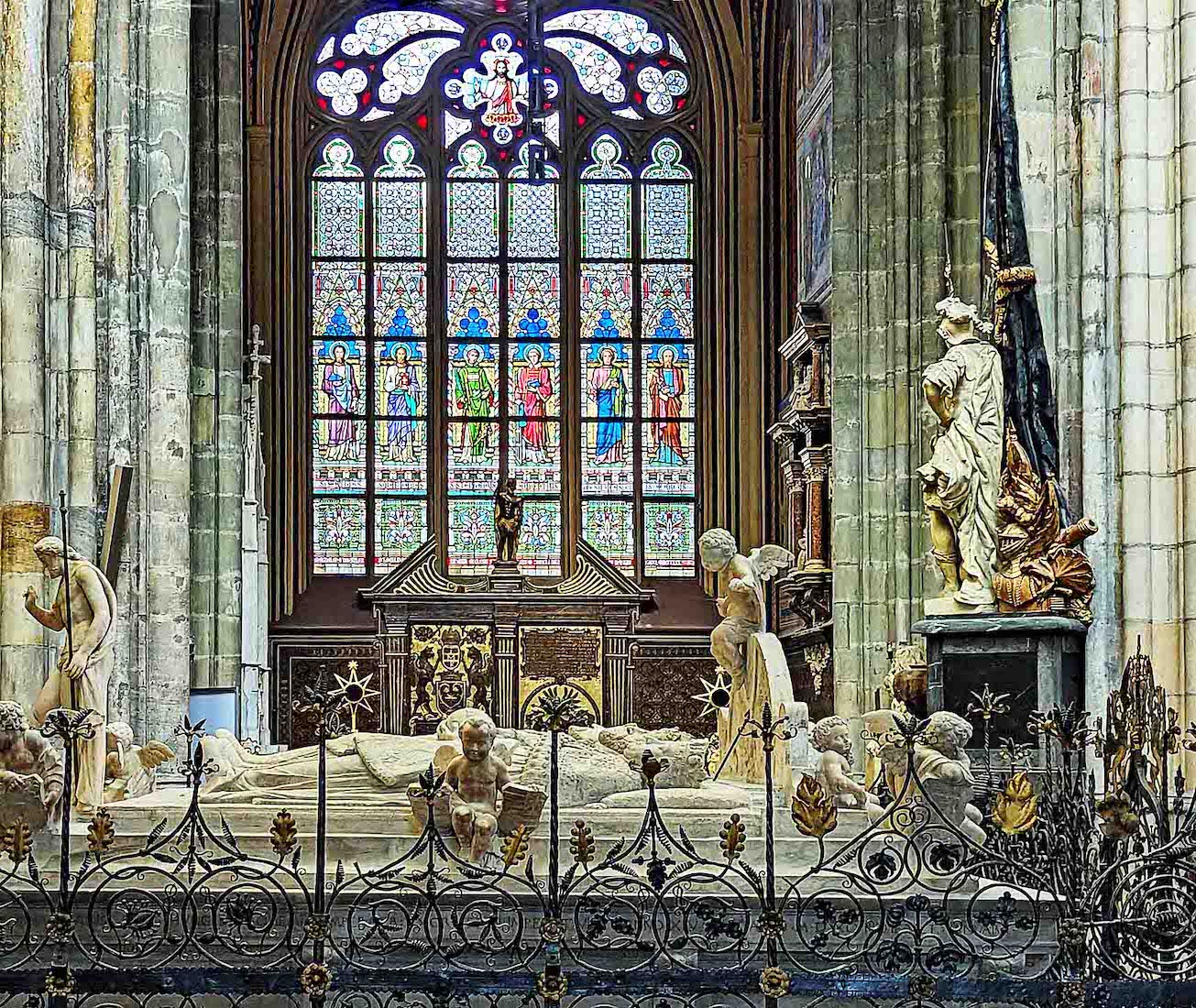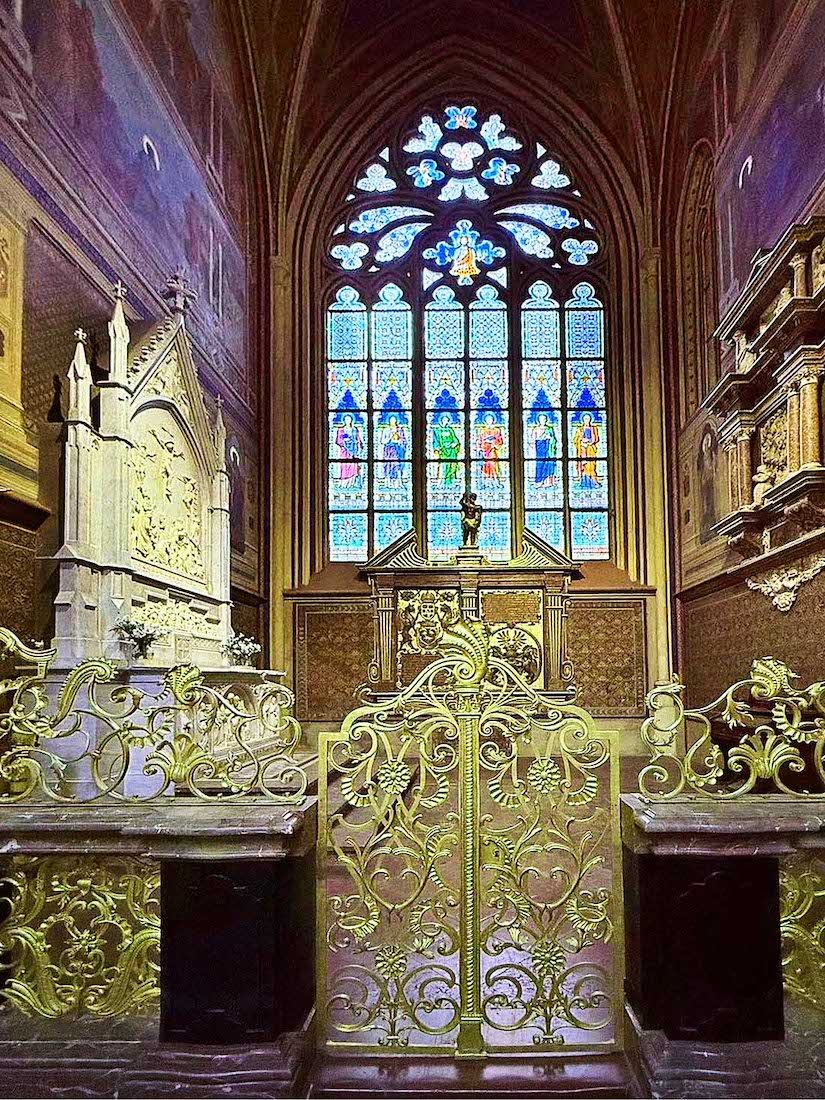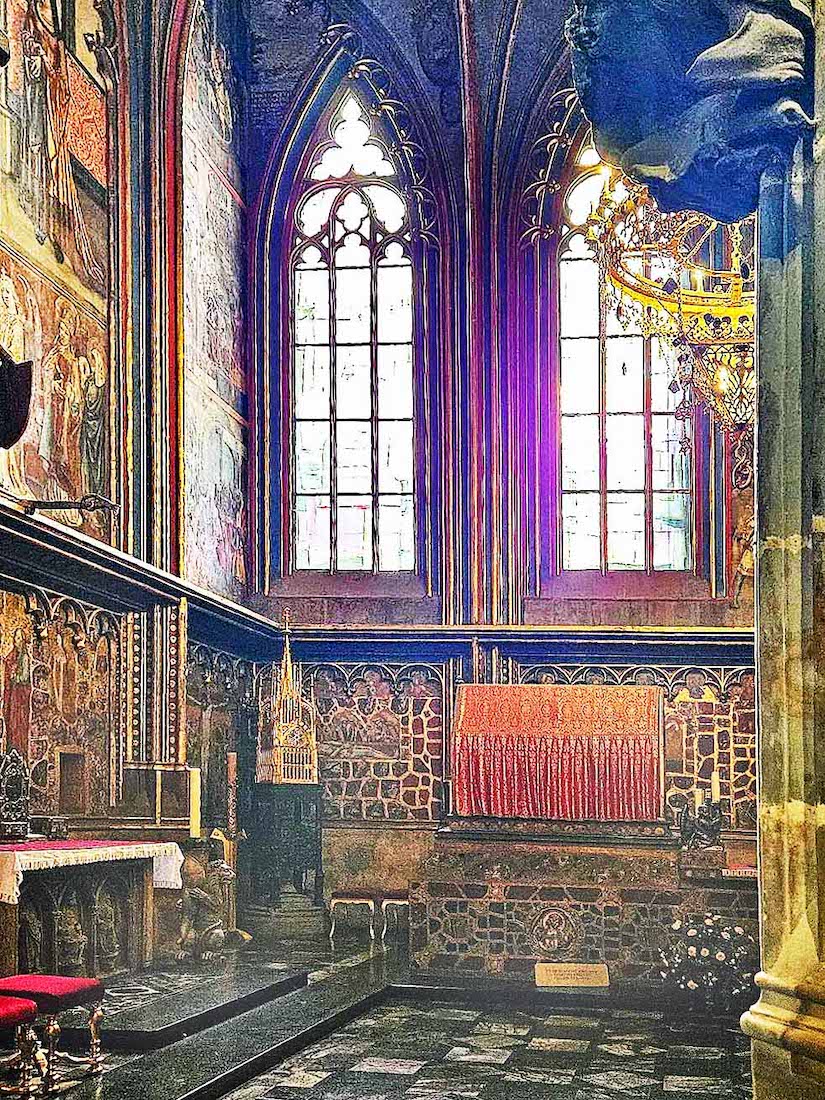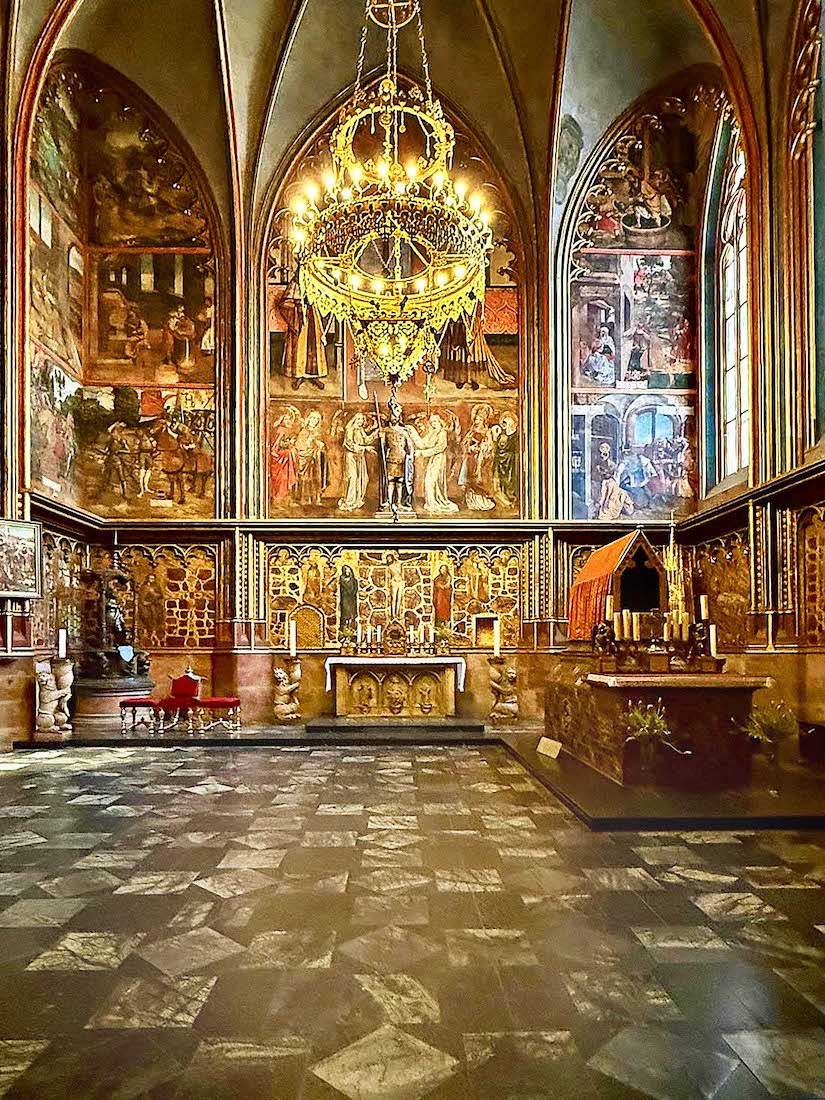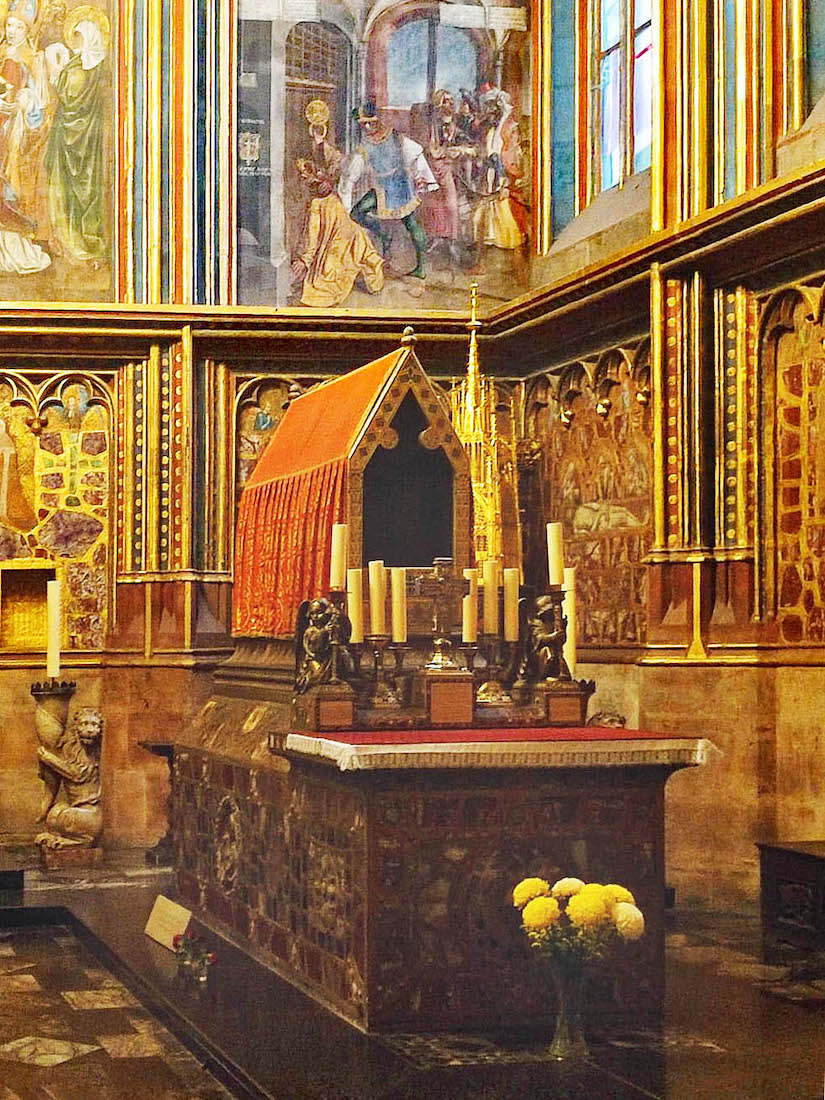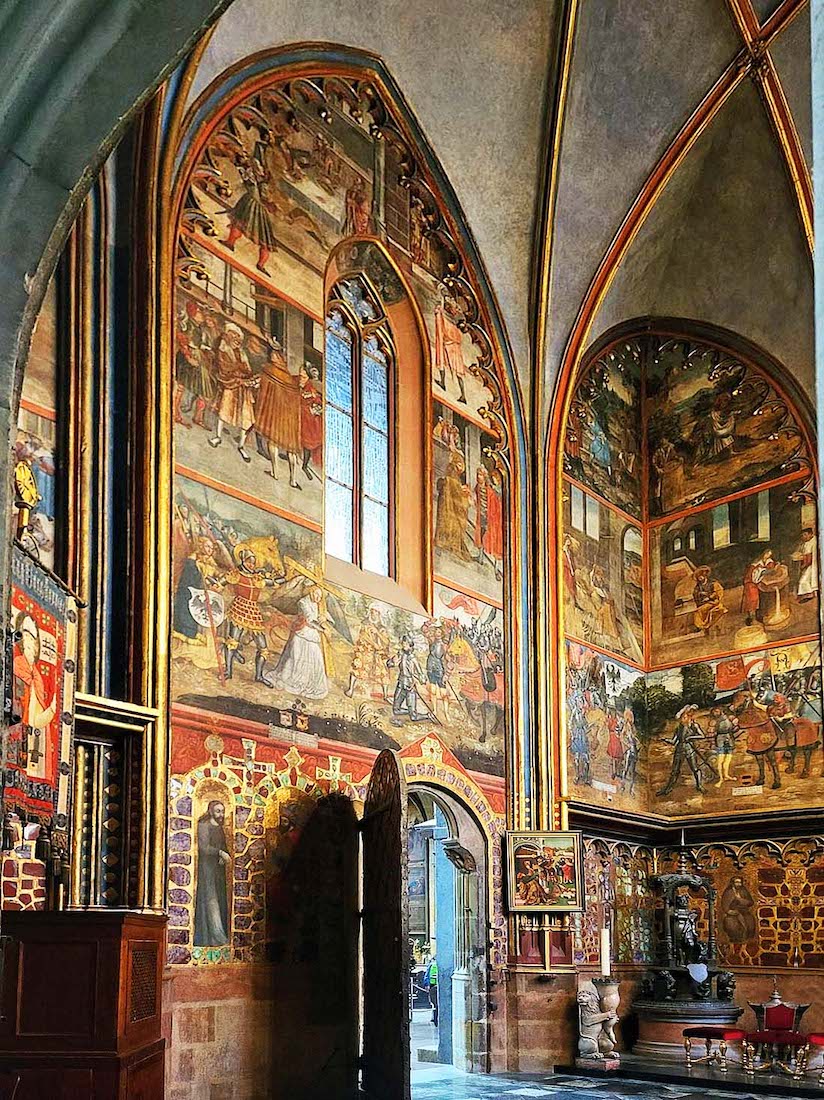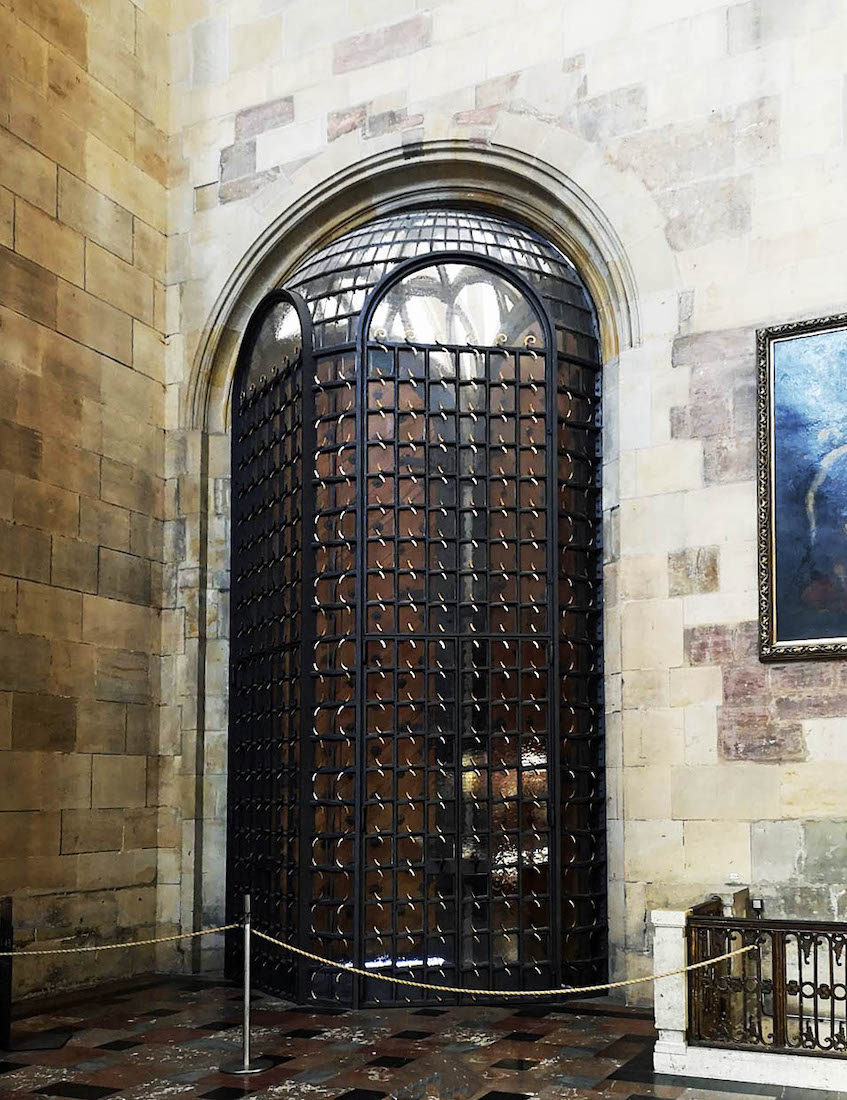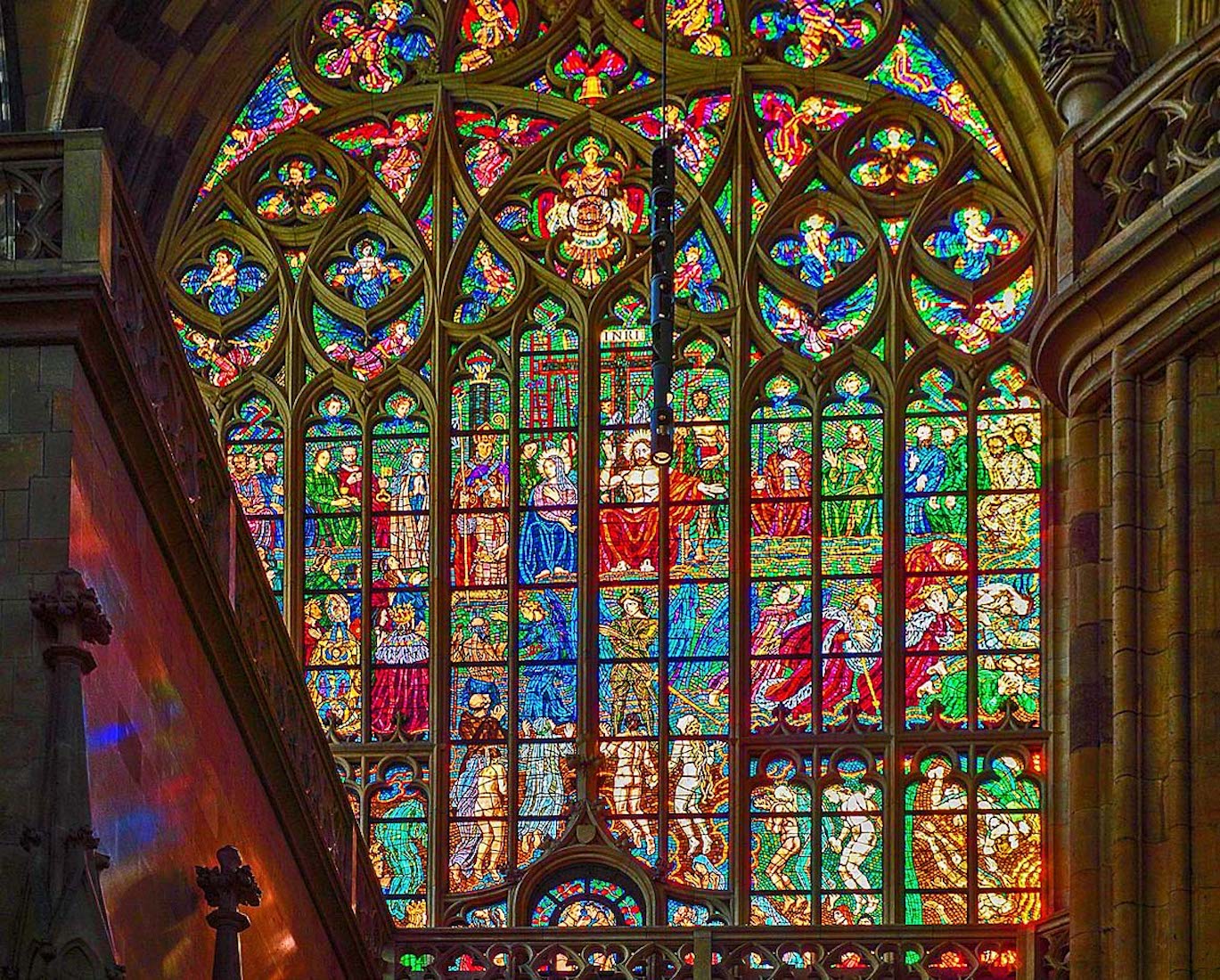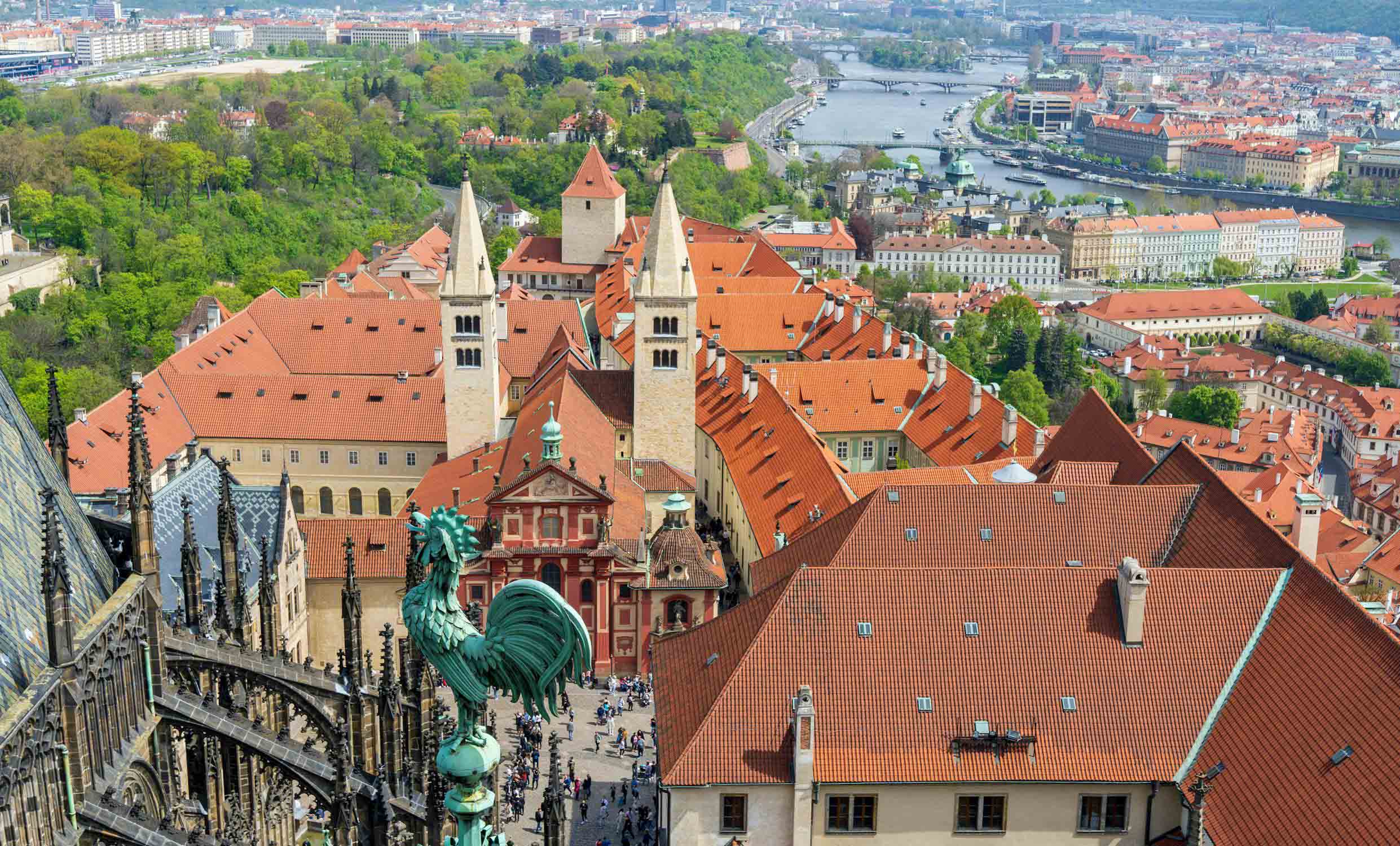C11. CARDINAL VON SCHWARZENBERG TA
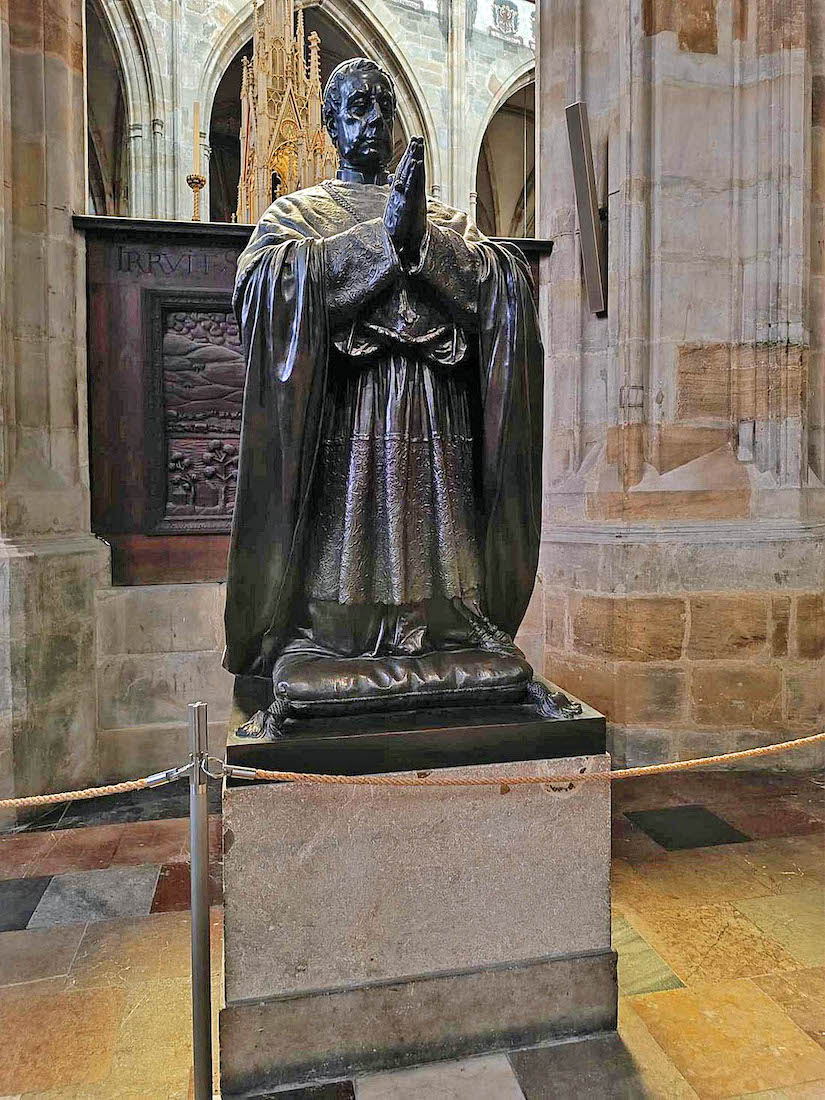
Right by the plaque stands Friedrich Prince of Schwarzenberg (1809 – 1885) – a Catholic Cardinal in Austria and the Kingdom of Bohemia, and a member of the House of Schwarzenberg. [Photo Credit: WILL GUILL 74] INDEX
C12. OLD ARCHBISHOP’S CHAPEL TA WC (x3)
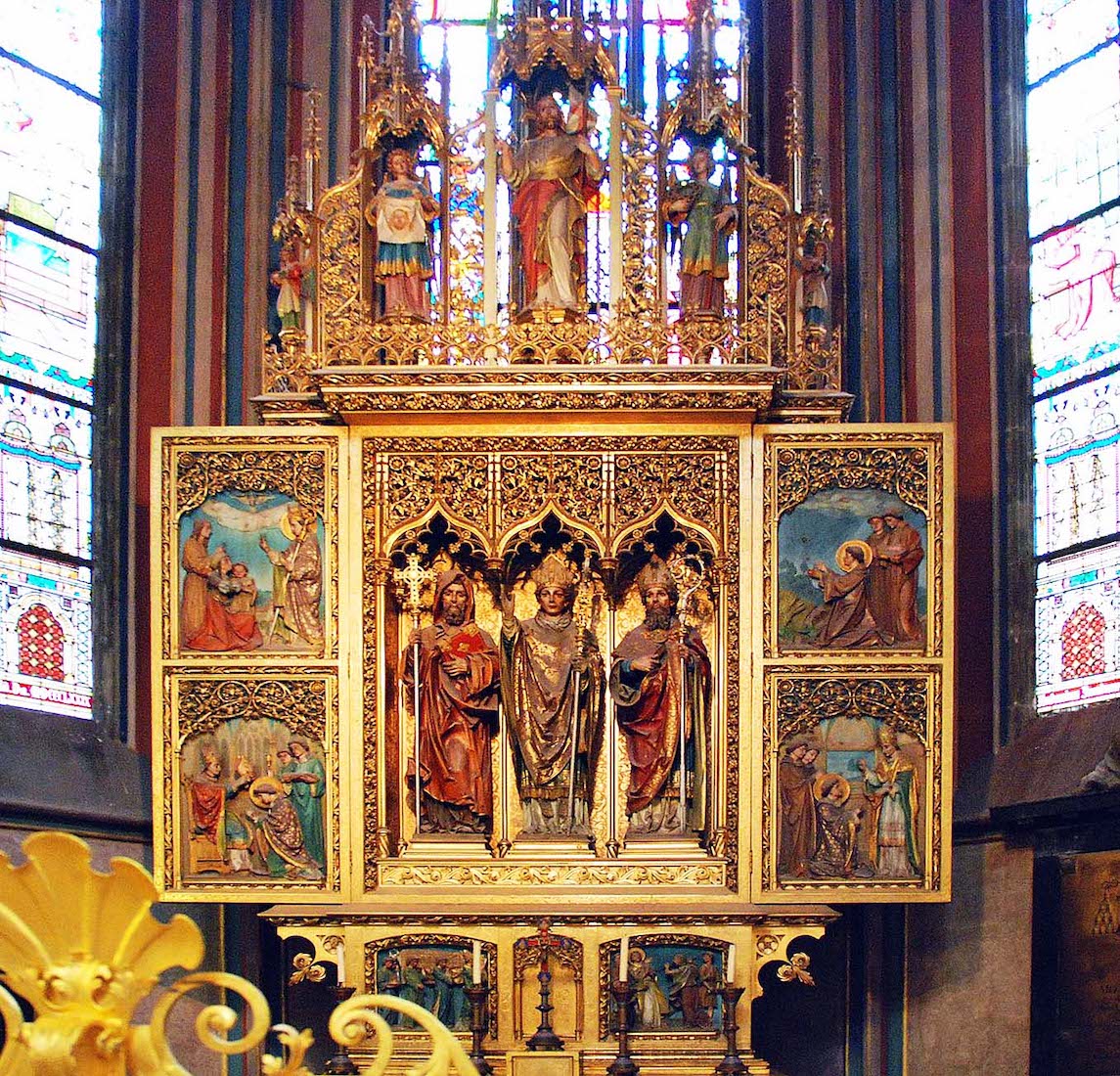

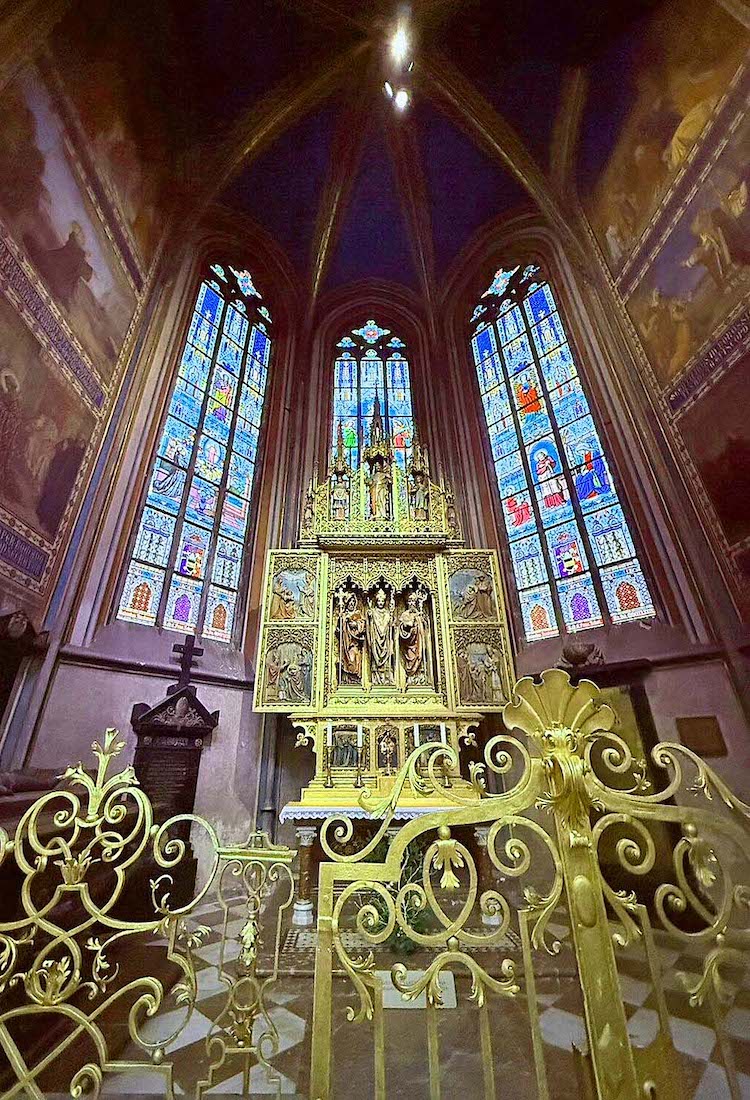
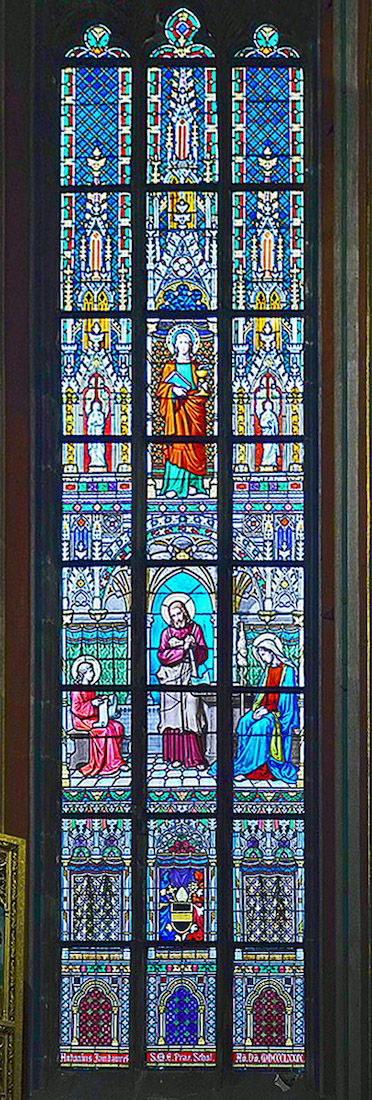
Back across to Chapel #12. The Old Archbishop’s Chapel is notable for its stunning stained glass windows, particularly the central window by Josef Mocker and František Sequens depicting Saint John of Nepomuk. In the left window, we have the Apostle Thomas and on the right the Apostle St. Jan. The chapel is also memorable for its beautiful golden triptych. Details of this are hard to find, but perhaps the central figure is St Vitus. [Photo1 Credit: Janmad] [Photo Credit: Edelmaus walggeist] [Photo3 Credit: nancy921] [Photo4 Credit: Ray Swi-Hymn4a]
C13. CHAPEL OF ST JOHN THE BAPTIST TA
Next is the Chapel of St John the Baptist. The chapel has three stained glass windows, with the central one being the oldest. These windows depict various religious figures and scenes, contributing to the Cathedral’s rich artistic heritage. To the sides of the chapel are Gothic tombs from the Parler workshop, specifically those of Břetislav II and Bořivoj II. These tombs showcase the intricate craftsmanship of the period. The altar features three main figures, which, based on the context of the Cathedral’s patronage, are likely to be St. Vitus in the centre, flanked by St. Wenceslas and St. Adalbert. [Photo Credit: Rob]
C14. LADY CHAPEL TA WC TA
The Lady Chapel stands at the centre of the apse, and is very grand, with fresco scenes on the side walls, and angels in the vaulting. Its special place is emphasised by the rood cross high above. There are three colourful windows. The central window has the Holy Trinity as its theme, but unfortunately the details are hidden by the altarpiece. But what an altarpiece! The triptych depicts ‘The Visitation’: the meeting of Mary and Elizabeth after the angel Gabriel visits Mary. Prague was one of the first places in the world to celebrate the feast of the Visitation, at the behest of Archbishop Jan Jenstein in the 1390s. [Photo1 Credit: Lauren] [Photo2 Credit: Ray Swi-Hymn5] [Photo3 Credit: Dieter H]
C15. ST VITUS TOMB; PLAN TA
Directly opposite the Lady Chapel, across the ambulatory, is the tomb of St Vitus. The tomb itself is quite simple, but there is a statue of the saint standing on it, and behind, a gold lattice makes for a dramatic display. Vitus, whose name is sometimes rendered Guy or Guido, was a Christian martyr from Sicily. His surviving hagiography is pure legend. The dates of his actual life are unknown, but notionally he was born in 290 AD, in Sicily, and died in 303 AD (age 13 years), in Basilicata, Italy. [Photo1 Credit: Michele]
C16. RELIQUARY CHAPEL TA WC
We come next to the Chapel of Relics, or Reliquary Chapel. The design of this chapel, completed in 1736, is attributed to F.M. Kaňka. It is claimed that this chapel houses relics of Saints Adalbert, John of Nepomuk, and Wenceslas, among others. [Photo1 Credit: nancy921] [Photo2 Credit: AlfonsMucha2]
C17. ST JOHN OF NEPOMUK TOMB TA (x4)
We move further around the ambulatory, coming to the tomb of St John (Jan) of Nepomuk. In contrast to the simple tomb of St Vitus, this tomb is a Baroque monument of opulent extravagance. It is cast in silver and silver-gilt, and was designed by Josef Emanuel Fischer of Erlach. •• There is a story ... . The wife of King Wencelas IV made confession to Vicar John, who then refused to reveal the confessional secrets to the King. For this he was tortured and thrown off the Charles Bridge in Prague, where his body supposedly floated on the surface for some time, surrounded by a halo of stars. He was beatified in 1721 and canonised in 1729. Saint Nepomuk is the patron saint of bridges and boatmen, and his statue (with a halo of golden stars) often appears on bridges and islands in Europe. His 1736 tomb contains two tons of silver. [Photos1,2 Credit: darthsansa14] [Photo3 Credit: luracaes] [Photo4 Credit: Marco Colli]
C18. JOHN NEPOMUK CHAPEL TA WC
Opposite his elaborate tomb is the Chapel of St John of Nepomuk which contains a relic of the saint. Years after his death, his body was pulled from the river and a part of his body (an arm), was saved in this reliquary. [Photo1 Credit: Rob] [Photo2 Credit: Avinash Bart]
C10 (2). SACKING OF THE CATHEDRAL
Almost opposite the Chapel of St John of Nepomuk, is another carved relief panel (see #10), this one depicting the sacking of the Cathedral in the 15th century. The Hussite Wars were a period of conflict in Bohemia (modern-day Czechia) in the 15th century. The Hussites, followers of Jan Hus, were a religious reform movement that challenged the authority of the Catholic Church and saw religious imagery as idolatrous. St. Vitus Cathedral and the Hussites: St. Vitus Cathedral was a significant target for the Hussite iconoclasts. The Cathedral’s extensive furnishings, including paintings, sculptures, and other religious artifacts, were considered to be objects of idolatry and were destroyed or damaged during the Hussite period.
C19. WALDSTEIN CHAPEL TA
The next chapel is the Waldstein Chapel, with a single window, and a large fresco on either side. The Waldstein Chapel is also known as the Mary Magdalene Chapel. It features a stained glass window depicting Saint Mary Magdalene washing the feet of Christ, with apostles Bartholomew and Matthew below. The chapel also contains the grave slabs of Cathedral architects Matthias of Arras and Peter Parler. The Waldsteins were an important family of nobles across Europe. [Photo Credit: nancy921]
C20. ROYAL ORATORY WC TA (x3)
At #20 we come to the Royal Oratory – an open space above which is a highly decorated balcony. This is where the Royal Family would come to attend mass, using the covered bridge we saw outside. The balcony has a ribbed vaulting designed to resemble tree branches, decorated with heraldic shields of the lands ruled by King Vladislav Jagellon. The oratory was built by Benedikt Ried and Hans Spiess. The decorative door at the back leads to a spiral staircase giving access to the upper level. On the Eastern supporting column of the oratory we find a prominent wooden statue of a miner ... but why? [Photo1 Credit: Russillo] [Photo2 Credit:Neil D] [Photo Credit: Rob] [Photo Credit: RJN612 ]
C21. CHAPEL OF THE HOLY ROOD SO WC
We come to the Chapel of the Holy Rood which features a crucifix as might be expected. However, it is probably best known as the point of access to the Royal Mausoleum (Crypt, Vault). [Photo1 Credit: samokolicaiput] [Photo2 Credit: Tony Higsett]
C22. ENTRANCE TO ROYAL VAULT GSV
We can go down steps here to visit the Royal Mausoleum. This is where Czech kings and queens found their eternal repose. We can pay homage to the illustrious rulers who shaped the nation’s history as we wander through this solemn space. The tombs, adorned with exquisite stone carvings, serve as a poignant reminder of the monarchy’s legacy. We can visit here ... . Just opposite, we notice a large monument.
C23. COUNT SCHLICK MONUMENT TA
Count Leopold Anton Joseph Schlick lived 1863 – 1723. He was a Field-Marshall and Chancellor of Bohemia. He is buried in the Cathedral, and this is his funerary monument. [Photo Credit: Lauren]
C24. ST ANDREW’S CHAPEL TA WC
Next we come to St Andrew’s Chapel. The window is of some interest here. In the centre, near the top is a curved rosette with the figure of Jesus, left hand out in blessing, and an open book in his right hand. Standing below are Saints Matthew, Barnabas, Lawrence, Luke and Mark. Across the chapel is the tomb of Bishop Johann von Dražice. [Photo1 Credit: nancy921] [Photo Credit:PaulT ]
C25. ST WENCESLAS’ CHAPEL TA (x4)
We come to the most outstanding place in the cathedral – the Chapel of St. Wenceslas, which houses relics of the saint. Peter Parler constructed the chapel between 1356 and 1364. The lower portions of the walls are decorated with over 1300 semi-precious stones and paintings depicting the Passion of Christ dating from the original decoration of the chapel in 1372–1373. The upper area of the walls have paintings depicting the life of St. Wenceslas, by the Master of the Litoměřice Altarpiece, painted between 1506 and 1509. Above the altar, is a Gothic statue of St. Wenceslas created by Jindřich Parler (Peter Parler’s nephew) in 1373. The chapel is not open to the public, but it can be viewed from the doorways. •• A small door with seven locks, in the Southwest corner of the chapel, leads to the Crown Chamber containing the Czech crown jewels, which are displayed to the public only once every eight years. [Photo1 Credit: Busker999] [Photo2 Credit: darthsansa14] [Photo3 Credit: Yannick N] [Photo4 Credit: NeilD]
C26. SOUTH TRANSEPT TA GSV GSV
This brings us to the South transept. The transept has a cluttered appearance due to the intrusion of the St Wenceslas Chapel at left, and the reinforced corner of the Great South Tower at right. However, our eyes are drawn to the dazzling stained glass window designed by Max Švabinský. The window was installed in 1938 and shows scenes from The Last Judgement. The window has some amazing detail: Christ sits in glory at the foot of the Cross along with Mary and various disciples, overseeing the images of heaven and hell at the base of the window. [Photo1 Credit: darthsansa14] [Photo3 Credit: Patryk Jankowski] [Photo4 Credit: Chinese]
C27. GREAT SOUTH TOWER WC
We are now passing the base of the Great South Tower. For those who are fit and strong, climbing the tower is a worthwhile feat! You can experience the climb without the effort here.


